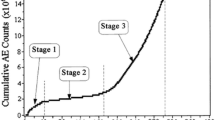Abstract
It is necessary to study the microlevel failure mechanisms of a material in order to improve its quality and to develop a rational constitutive model to describe the material. Nonlinearity and strain-softening behavior of concrete has to be incorporated into any model which can be implemented into efficient design. Acoustic-emission (AE) techniques are useful for obtaining information pertaining to internal cracking and investigating the applicability of a particular material model.
The process of localization of cracks and movement of the fracture process zone was studied using acoustic-emission techniques. The rate of acoustic-emission events and sources of acoustic-emission activity were studied for plain-mortar and model-concrete specimens loaded in direct tension.
The study shows that acoustic-emission events localize to a region near the notch before peak load is attained. The region of activity progresses through the specimen during further loading and subsequent strain softening. Acoustic-emission events were used to locate the fracture-process zone (FPZ), and to check this location against the location of the effective crack tip as evaluated by a modified linear-elastic fracturemechanics model for concrete as well as by microscopical observations.
Similar content being viewed by others
References
Jenq, Y.S. and Shah, S.P., “Nonlinear Fracture Parameters for Cement Based Composites: Theory and Experiments,” Application of Fracture Mechanics to Cementitious Composites, ed. S.P. Shah, Martinus Nijhoff, 319–336 (1985).
Labuz, J., Shah, S.P., andDowding, C.H., “Experimental Analysis of Crack Propagation in Granite,”Int. J. Rock Mech. and Mining Sci.,22,85–98 (1985).
Swanson, P.L. and Spetzler, H., “Ultrasonic Probing of Fracture Process Zone in Rock Using Surface Waves,” Proc. 25th U.S. Symp. on Rock Mech., 67–76 (1984).
Ingraffea, A.R. and Gerstle, W.H., “Non-Linear Fracture Models for Discrete Crack Propagation,” Application of Fracture Mechanics to Cementitious Composites, ed. S.P. Shah, Martinus Nijhoff, 247–286 (1985).
Diamond, S. andMindess, S., “A Device for Direct Observation of Cracking of Cement Paste and Mortar Under Compressive Loading within a Scanning Electron Microscope,”Cement and Concrete Res.,12 (5),569–576 (1982).
John, R. andShah, S.P., “Fracture of Concrete Subjected to Impact Loading,” J. of Cement, Concrete and Aggregates, ASTM,8 (1),24–32 (Summer 1986).
Swartz, S.E., Hu, K.K. andJones, G.L., “Compliance Monitoring of Crack Growth in Concrete,”J. Eng. Mech., ASCE,104 (EM4),789–800 (Aug. 1978).
Knab, L.I., Walder, H.N., Clifton, J.R. andFuller, E.R., “Fluorescent Thin Sections to Observe the Fracture Process Zone in Concrete,”Cement and Concrete Res.,14, 339–344 (1984).
Kobayashi, A.S., Hawkins, N.M., Barker, D.B. and Liaw, B.M., “Fracture Process Zone in Concrete,” Applications of Fracture Mechanics to Cementitious Composites, ed. S.P. Shah, Martinus Nijhoff, 25–50 (1985).
Hamstad, M.A., “A Review: Acoustic Emission, A Tool for Composite Materials Studies,” Experimental Mechanics (March 1986).
Izsumi, M., Mihashi, H. and Nomura, N., “Acoustic Emission Technique to Evaluate Fracture Mechanics Parameter in Concrete,” Proc. 7th Int. Acoustic Emission Symp., 200 (Oct. 1984).
Tanigawa, Y., Yamada, K. andKiriyama S., “Frequency Characteristics of Acoustic Emission Waves in Concrete,”Trans. Jap. Concrete Inst.,2,155–162 (1980).
Labuz, J., Shah, S.P. andDowding, C.D., “Measurements and Description of the Tensile Fracture Process in Rock,”Int. J. Rock Mech. and Mining Sci.,24 (4),235–246 (Aug. 1987).
Seruby, C.B., Baldwin, G.R. andStacey, K.A., “Characterization of Fatigue Crack Extension by Quantitative Acoustic Emission,”Int. J. Fract.,28,201–222 (1985).
Michaels, J.E., Michaels, T.E. and Sachse, W., “Applications of Deconvolution to Acoustic Emission Signal Analysis,” Mat. Eval., 1391, 1032 (1981).
Gopalaratnam, V.S. and Shah, S.P., “Softening Response of Plain Concrete in Direct Tension,” ACI J., 310–323 (May–June 1985).
Labuz, J.F., Chang, H.S., Dowding, C.H. and Shah, S.P., “Location Analysis of Acoustic Emission During Fracture of laboratory Specimens,” to be published, Rock Mech and Rock Eng.
Jenq, Y.S. andShah, S.P., “A Fracture Toughness Criterion for Concrete,”Engineering Fracture Mechanics,21 (5),1055–1069, (1985).
Jenq, Y.S. andShah, S.P., “Two Parameter Fracture Model for Concrete,”J. Eng. Mech., ASCE 111 (10),1227–1241 (Oct. 1985).
Author information
Authors and Affiliations
Rights and permissions
About this article
Cite this article
Maji, A., Shah, S.P. Process zone and acoustic-emission measurements in concrete. Experimental Mechanics 28, 27–33 (1988). https://doi.org/10.1007/BF02328992
Received:
Revised:
Issue Date:
DOI: https://doi.org/10.1007/BF02328992




